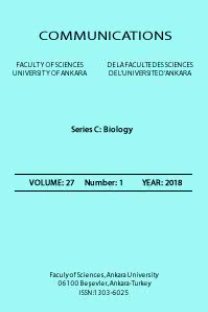AGE DETERMINATION OF FOSSILS COLLECTED FROM KARABÜK, SAFRANBOLU, BULAK RIVER AREA BY USING AMINO ACID RACEMIZATION METHOD
Amino acid racemization, fossils, age determination, Karabük, Safranbolu
___
C.A. Challener, Overview of chirality. In: Chiral drugs, 1st. Aldershot (England): Ashgate Publisher, 3-14, 2001.D.E. Drayer, The early history of stereochemistry. In: Drug stereochemistry, Analytical methods and pharmacology, I.W. Wainer, editor. New York: Marcel Dekker Publisher. 1-24, (1993).
L.A. Nguyen, H. He, and C. Pham-Huy, Chiral drugs: an overview, International Journal of Biomedical Science, 2(2), (2006) 85.
H.B. Vickery, Rules for the nomenclature of the natural amino acids and related substances. Journal of Biological Chemistry, 169(2), (1947) 237-245.
J.L. Bada, Racemization of amino acids. In: Chemistry and biochemistry of the amino acids, Dordrecht: Springer. 399-414, 1985.
B.J. Johnson and G.H. Miller, Archaeological applications of amino acid racemization, Archaeometry. 39(2), (1997) 265-287.
A. Julg, Origin of the L-homochirality of amino-acids in the proteins of living organisms. In: Molecules in Physics, Chemistry, and Biology. Dordrecht: Springer. 33-52, 1989.
J.L. Bada, Amino acid racemization dating of fossil bones, Annual Review of Earth and Planetary Sciences, 13(1), (1985) 241-268.
J. Csapo, Z. S. Kiss-Csapo, C. Albert and K. Lóki, Hydrolysis of proteins performed at high temperatures and for short times with reduced racemization, in order to determine the enantiomers of D-and L-amino acids, Acta Univ. Sapientiae, Alimentaria, 1, (2008) 31-48.
K. Alkass, B.A. Buchholz, S. Ohtani, T. Yamamoto, H. Druid and K.L. Spalding, Age estimation in forensic sciences application of combined aspartic acid racemization and radiocarbon analysis, Proteomics.,9(5), (2010) 1022-1030.
A. Koçyiğit, Karabük‐Safranbolu Tersiyer havzası kuzey kenarının stratigrafisi ve niteligi, Bull. Geol. Soc. Turk. 30, (1987) 61-69.
J. Csapó, C. Albert, K. Lóki and G. Pohn, Age determination based on amino acid racemization: a new possibility, Acta Univ. Sapientiae, 1, (2008) 109-118.
J. Blamire, Kjeldahl Method, http://www.brooklyn.cuny.edu/bc/ahp/ SDKC/Chem/SD_KjeldahlMethod.html, (2003) Retrieved 11/04/2018.
R.C. Team, R: A language and environment for statistical computing, 2013.
- ISSN: 1303-6025
- Yayın Aralığı: Yılda 2 Sayı
- Başlangıç: 1943
- Yayıncı: Ankara Üniversitesi
Sibel KARA, Tahir ÖZDEMİR, Ergin Murat ALTUNER
EXAMINATION OF POLLEN MORPHOLOGY OF SOME AETHIONEMA (BRASSICACEAE), FROM TURKEY
Talıp CETER, Fatmagul GEVEN, Aydan ACAR ŞAHİN, Selin CETER
Berrin BALDAS, Ergin Murat ALTUNER
THE MORPHOLOGICAL PROPERTIES OF LEAVES, CONES, SEEDS OF SOME JUNIPERUS SPECIES NATIVE TO TURKEY
Ayşegül KÖROĞLU, Gülsen KENDİR, Derya ŞİMŞEK, Natalizia MICELI, Nur Münevver PINAR
Esra KOÇ, Cemil İŞLEK, Nurhan BÜYÜKKARTAL HATİCE
URBAN FAUNAL DYNAMICS OF BEYTEPE CAMPUS, ANKARA: Three Case Studies for Vertebrate Animals
